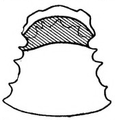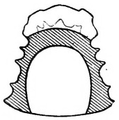Approximants are speech sounds that involve the articulators approaching each other but not narrowly enough nor with enough articulatory precision to create turbulent airflow. Therefore, approximants fall between fricatives, which do produce a turbulent airstream, and vowels, which produce no turbulence. This class is composed of sounds like and semivowels like and, as well as lateral approximants like.
A fricative is a consonant produced by forcing air through a narrow channel made by placing two articulators close together. These may be the lower lip against the upper teeth, in the case of ; the back of the tongue against the soft palate in the case of German ; or the side of the tongue against the molars, in the case of Welsh. This turbulent airflow is called frication.
Uvulars are consonants articulated with the back of the tongue against or near the uvula, that is, further back in the mouth than velar consonants. Uvulars may be stops, fricatives, nasals, trills, or approximants, though the IPA does not provide a separate symbol for the approximant, and the symbol for the voiced fricative is used instead. Uvular affricates can certainly be made but are rare: they occur in some southern High-German dialects, as well as in a few African and Native American languages. Uvular consonants are typically incompatible with advanced tongue root, and they often cause retraction of neighboring vowels.

Pharyngealization is a secondary articulation of consonants or vowels by which the pharynx or epiglottis is constricted during the articulation of the sound.
In phonetics, ejective consonants are usually voiceless consonants that are pronounced with a glottalic egressive airstream. In the phonology of a particular language, ejectives may contrast with aspirated, voiced and tenuis consonants. Some languages have glottalized sonorants with creaky voice that pattern with ejectives phonologically, and other languages have ejectives that pattern with implosives, which has led to phonologists positing a phonological class of glottalic consonants, which includes ejectives.

A digraph or digram is a pair of characters used in the orthography of a language to write either a single phoneme, or a sequence of phonemes that does not correspond to the normal values of the two characters combined.

A retroflex, apico-domal, or cacuminalconsonant is a coronal consonant where the tongue has a flat, concave, or even curled shape, and is articulated between the alveolar ridge and the hard palate. They are sometimes referred to as cerebral consonants—especially in Indology.
In phonetics, a trill is a consonantal sound produced by vibrations between the active articulator and passive articulator. Standard Spanish ⟨rr⟩ as in perro, for example, is an alveolar trill.
In phonetics, a flap or tap is a type of consonantal sound, which is produced with a single contraction of the muscles so that one articulator is thrown against another.
In phonetics, nasalization is the production of a sound while the velum is lowered, so that some air escapes through the nose during the production of the sound by the mouth. Examples of archetypal nasal sounds include and.

The voiceless velar lateral fricative is a rare speech sound. As one element of an affricate, it is found for example in Zulu and Xhosa. However, a simple fricative has only been reported from a few languages in the Caucasus and New Guinea.
Doubly articulated consonants are consonants with two simultaneous primary places of articulation of the same manner. They are a subset of co-articulated consonants. They are to be distinguished from co-articulated consonants with secondary articulation; that is, a second articulation not of the same manner. An example of a doubly articulated consonant is the voiceless labial–velar plosive, which is a and a pronounced simultaneously. On the other hand, the voiceless labialized velar plosive has only a single stop articulation, velar, with a simultaneous approximant-like rounding of the lips. In some dialects of Arabic, the voiceless velar fricative has a simultaneous uvular trill, but this is not considered double articulation either.
Yeyi is a Bantu language spoken by many of the approximately 50,000 Yeyi people along the Okavango River in Namibia and Botswana. Yeyi, influenced by Juu languages, is one of several Bantu languages along the Okavango with clicks. Indeed, it has the largest known inventory of clicks of any Bantu language, with dental, alveolar, palatal, and lateral articulations. Though most of its older speakers prefer Yeyi in normal conversation, it is being gradually phased out in Botswana by a popular move towards Tswana, with Yeyi only being learned by children in a few villages. Yeyi speakers in the Caprivi Strip of north-eastern Namibia, however, retain Yeyi in villages, but may also speak the regional lingua franca, Lozi.
The voiceless velar lateral affricate is a relatively uncommon speech sound found as a phoneme in the Caucasus and as an allophone in several languages of eastern and southern Africa. In strict IPA, it needs to be transcribed with diacritics, but a proper letter exists in extIPA: ⟨k͜𝼄⟩.
The velar lateral ejective affricate is a rare type of consonantal sound, used in some spoken languages. The symbol in the International Phonetic Alphabet that represents this sound is ⟨k𝼄ʼ⟩.
Ejective-contour clicks, also called sequential linguo-glottalic consonants, are consonants that transition from a click to an ejective sound, or more precisely, have an audible delay between the front and rear release of the click. All click types have linguo-glottalic variants, which occur as both stops and affricates, and may be voiced. At least a voiceless linguo-glottalic affricate is attested from all Khoisan languages of southern Africa, as well as from the Bantu language Yeyi from the same area, but they are unattested elsewhere.
Wadiyara Koli is an Indo-Aryan language of the Gujarati group. It is spoken by the Wadiyara people, who originate from Wadiyar in Gujarat; many of whom are thought to have migrated to Sindh in the early twentieth century, following the onset of famine. The Wadiyara people are affiliated with the Bhil people and Koli people, but are generally more inclined towards associating themselves with the Koli; they are often regarded as a subgroup of the latter.
Adyghe is a language of the Northwest Caucasian family which, like the other Northwest Caucasian languages, is very rich in consonants, featuring many labialized and ejective consonants. Adyghe is phonologically more complex than Kabardian, having the retroflex consonants and their labialized forms.





